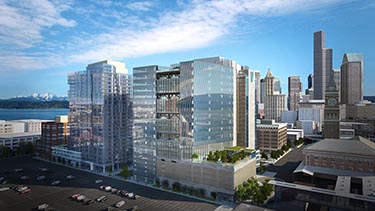|
Subscribe / Renew |
|
|
Contact Us |
|
| ► Subscribe to our Free Weekly Newsletter | |
| home | Welcome, sign in or click here to subscribe. | login |
Environment
| |
June 18, 2015
New program helps with LEED certification
Journal Staff Reporter
The U.S. Green Building Council's Leadership in Energy and Environmental Design program encourages design, construction and operation of green buildings.
The LEED rating systems for new construction, tenant improvement and existing buildings each have sustainable strategies projects can use to get LEED certified. They are intentionally broad to apply to different types of projects, but sometimes it's difficult to know if a strategy will get LEED points without talking to a LEED reviewer.
Now the Green Building Certification Institute is making it easier for firms to form a professional relationship with LEED reviewers via its Proven Provider program launched in September. The GBCI provides certification for the LEED rating systems for the council.
Proven Provider rewards organizations such a green building consultants and architecture and engineering firms that have consistently offered high quality LEED submissions, said Sarah Alexander, vice president of certification with the institute. To be eligible, you must submit LEED certified projects in each LEED rating systems family — new buildings, interior design or existing buildings — in which you want to be designated a Proven Provider.
Alexander said the designation is valuable.
“It provides you with a marketing advantage that you are one of a select group that demonstrates that it really knows what it's doing when it comes to LEED or LEED submissions,” she said.
Alexander said there are about 54 Proven Providers, 250 others are being evaluated for the designation across the world and an equal number have expressed interest.
Proven Providers can get their projects through the LEED certification process faster than firms that do not have that designation, she said.
Proven Providers can get a dedicated LEED reviewer assigned to their organization so they can build a relationship, “and on our side it's really helpful to get direct feedback,” Alexander said.
Seattle-based green building consultant ArchEcology helped beta test Proven Provider, and was awarded the designation in the building design & construction (new buildings) rating system.
Michelle Rosenberger, a partner at the firm, said the designation has already made a difference.
ArchEcology was working with the developer of warehouse project on former farmland in Sumner. The developer was restoring land on the site to native habitat so it could deed it back to the city for a trail, she said. That approach met the intent of LEED's requirements, but not the exact definition. Rosenberger said that's because LEED gives credit for restoration of a previously developed site, and the definition didn't consider farmland as previously developed.
But Rosenberger said she was able to talk to a LEED reviewer, so the developer got credit for the habitat work.
“In the old days we would have made our best guess at interpreting the intent, and we would have sent it up there and crossed our fingers,” she said.
Rosenberger said that, with the LEED program, “The unfortunate thing is you can do the right thing but not always get credit for it because of the rigorous requirements of certification. ... It's quite difficult actually if you don't get to talk to the people. LEED is not one-size fits-all, and it tries to be.”
ArchEcology has more than 50 LEED certified projects totaling 5 million square feet, and is working to get 30 projects LEED certified. It was founded in 2006 by architect Nancy Henderson. Rosenberger does project management and business development.
Each project seeking LEED must comply with seven or eight prerequisites and then selects additional sustainable measures from a menu of options to arrive at an overall score. Levels of certification are based on their final scores – certified at 40 points, silver at 50 points, gold at 60 points and platinum at 80 points.
Some of the sustainable measures that go towards being LEED certified are obvious, such as an urban project getting points for having public transit nearby, said Rosenberger, but “then you get into what's a maybe.”
She said her clients believe LEED certified buildings lease up faster, have less turnover and that tenants now expect buildings to be green. Plenty of public agencies require LEED certification, she said, and many of ArchEcology's clients are going for LEED because their financial partner is requiring it. Also, she said, LEED buildings in Seattle can get additional floor area or height during the permitting process; in South Lake Union, for example, buildings that pursue LEED gold certification can get that.
Rosenberger said LEED promotes higher quality construction and addresses conservation and reuse of energy and water, commodities that likely will be volatile in the future.
Lynn Porter can be
reached by email or by phone
at (206) 622-8272.



